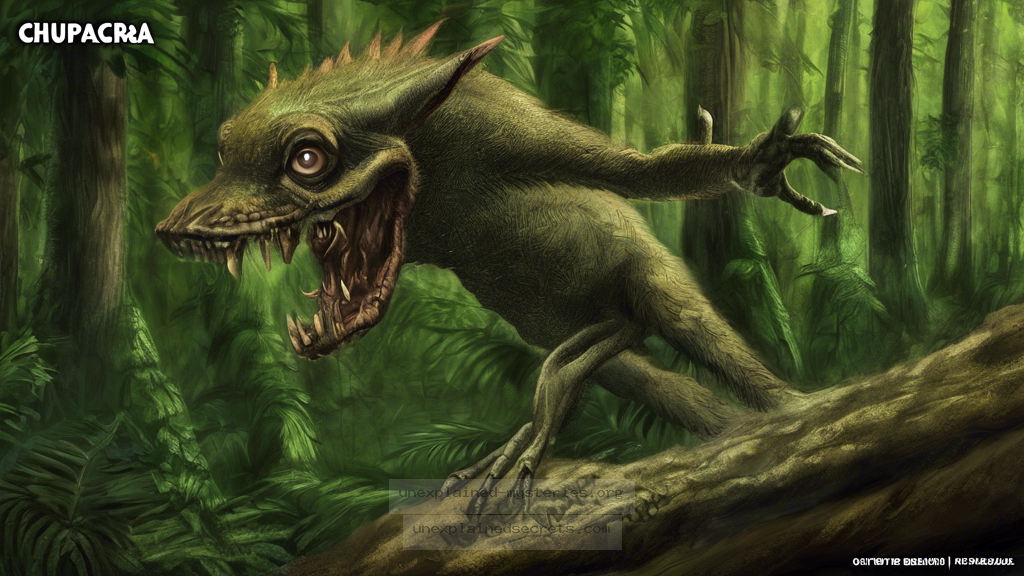What Lies Beneath the Forest Canopy: The Mystery of the Chupacabra?
What Lies Beneath the Forest Canopy: The Mystery of the Chupacabra?
The Chupacabra is one of the most infamous cryptids to roam the realms of folklore and modern mythology. This mysterious creature, often described as a bloodsucking beast, has captured the imagination of many and sparked countless investigations. But what makes the Chupacabra such a compelling topic in cryptozoology? Is it merely a product of local legends and fears, or is there a deeper mystery that needs to be unraveled? In this article, we will delve into the origins, sightings, and theories surrounding the Chupacabra, exploring why it remains an enigmatic figure in the world of cryptids.
Historical Context: The Birth of a Legend
The Chupacabra first emerged in the late 1990s in Puerto Rico, where reports of livestock being found drained of blood began to surface. The term “Chupacabra,” which translates to “goat-sucker,” was coined after witnesses described the creature’s penchant for attacking goats and other farm animals. The phenomenon spread rapidly, with reports appearing across Latin America and eventually making their way into the United States.
In 1995, a series of mysterious animal deaths were reported in Puerto Rico. Farmers claimed to have found their goats and chickens with puncture wounds and completely drained of blood. This led to widespread panic and speculation about the creature’s origins. Could it be an unknown species, a government experiment gone wrong, or simply a manifestation of local superstition? The Chupacabra quickly became a cultural icon, inspiring numerous articles, books, and even television shows.
- First reported in Puerto Rico in the mid-1990s.
- Associated with livestock deaths, particularly goats.
- Rapid spread of sightings across Latin America and the U.S.
Core Concepts: What is the Chupacabra?
The Chupacabra is typically described as a reptilian creature with spines along its back, standing about three to four feet tall. Witnesses often depict it with glowing red eyes, sharp fangs, and a penchant for stealth. However, descriptions vary widely, complicating the search for the truth behind this cryptid. Some accounts describe it as more canine in appearance, leading to theories that it could be a misidentified animal.
One core concept in understanding the Chupacabra is the overlap between myth and reality. Many cryptozoologists argue that the creature is a reflection of cultural fears and societal issues, such as economic instability and environmental degradation. The Chupacabra serves as a symbol of the unknown, representing our fears of what lurks just beyond the edges of our understanding.
Notable Sightings: Documented Cases of the Chupacabra
Over the years, numerous sightings of the Chupacabra have been reported. Here are a few notable cases:
| Date | Location | Description |
|---|---|---|
| 1995 | Puerto Rico | Initial reports of livestock deaths; first known mention of the Chupacabra. |
| 2000 | Miami, Florida | A man claimed to have captured a creature resembling the Chupacabra; later identified as a hairless dog. |
| 2004 | Texas | A rancher discovered several goats dead with puncture wounds; sighting of a creature resembling the Chupacabra was reported. |
| 2010 | Chile | Local farmers reported sightings of a creature attacking livestock; described as a “hairless dog.” |
These sightings have collectively shaped the Chupacabra’s image, leading to widespread media coverage and public intrigue. However, they have also drawn skepticism, as many of the reported encounters can be attributed to misidentification or hoaxes.
Theories Behind the Chupacabra: Is it a Real Creature?
There are several theories regarding the existence and nature of the Chupacabra:
- Misidentification: Many skeptics argue that Chupacabra sightings are simply cases of misidentified animals. Hairless dogs, coyotes, or other wildlife could easily be mistaken for the legendary beast, especially when seen in low light.
- Urban Legends: The Chupacabra may be a modern urban legend, a cultural phenomenon that has taken on a life of its own. As stories spread, they adapt and mutate, making it difficult to separate fact from fiction.
- Genetic Mutations: Some researchers suggest that the Chupacabra could be a genetically mutated animal, perhaps resulting from environmental factors or diseases affecting local wildlife.
- Extraterrestrial Origins: A more fringe theory posits that the Chupacabra could be an alien life form, brought to Earth through extraterrestrial activity. While this idea is often dismissed, it still fascinates conspiracy theorists.
The truth may lie somewhere in between these theories, highlighting the complexity of cryptozoological investigations.
Common Misconceptions: Debunking the Myths
As with many legends, the Chupacabra is surrounded by misconceptions that often cloud public understanding.
- It’s Always a Monster: While the Chupacabra is often depicted as a monstrous creature, many sightings have been described as relatively mundane animals suffering from mange or other diseases.
- It Only Attacks Goats: Although its name implies a focus on goats, reports indicate that the Chupacabra has attacked a variety of animals, including chickens and even dogs.
- All Sightings Are Credible: Some sightings are based on hearsay or sensationalized accounts, which can lead to misinformation and panic within communities.
Understanding these misconceptions is essential for anyone interested in serious research on cryptids and the phenomenon of the Chupacabra.
Practical Implications: Investigating the Chupacabra
For those interested in investigating the Chupacabra phenomenon, several best practices can enhance the quality of research:
- Document Witness Accounts: Collect detailed accounts from eyewitnesses, including time, location, and descriptions of the creature.
- Examine Evidence: Look for physical evidence, such as hair samples or footprints, and analyze them scientifically.
- Engage with Local Communities: Understanding local folklore and cultural context can provide insights into how the Chupacabra is perceived and why it has become a part of local lore.
- Collaborate with Experts: Work with biologists, ecologists, and cryptozoologists to better understand the wildlife in the area and to separate fact from fiction.
Investigations should be conducted ethically and respectfully, keeping in mind the cultural significance of local legends.
Future Developments: Ongoing Research and Interest
As technology advances, so too does the potential for investigating cryptids like the Chupacabra. Genetic analysis and environmental DNA (eDNA) sampling are becoming increasingly accessible methods for researchers. These techniques can help identify unknown species and clarify whether the Chupacabra is a mythical construct or a real creature.
Moreover, the rise of citizen science and community engagement in paranormal research has led to a renewed interest in cryptids. Social media platforms allow individuals to share sightings and evidence, fostering a collaborative environment for investigation.
Conclusion: The Chupacabra Remains Elusive
The Chupacabra continues to intrigue enthusiasts and skeptics alike, standing as a symbol of humanity’s fascination with the unknown. From its origins in Puerto Rican folklore to its spread across the globe, this creature embodies the intersection of myth, fear, and the quest for understanding. Whether a figment of imagination or a real entity, the Chupacabra’s mystery invites ongoing exploration and dialogue in the field of cryptozoology.
As we continue to investigate the depths of our world and the creatures that inhabit it, one thing remains certain: the allure of the Chupacabra will persist, challenging our perceptions of the natural world and its hidden secrets.
Other Articles
Recent Posts
- What Happened to Flight MH370? The Conspiracy Theories That Still Haunt Us
- What Secrets Lurk Within the Walls of the Infamous Trans-Allegheny Lunatic Asylum?
- What Evidence Supports the Existence of Bigfoot in the Pacific Northwest?
- What Happened to the Indus Valley Civilization? Unraveling the Mysteries of Ancient Urban Life
- Can Telepathy Be Scientifically Proven Through Laboratory Evidence?







